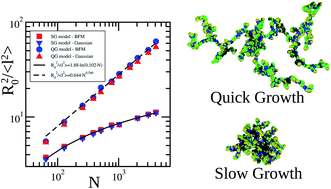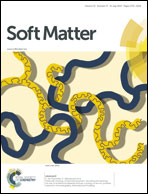Two universality classes for random hyperbranched polymers
Abstract
We grow AB2 random hyperbranched polymer structures in different ways and using different simulation methods. In particular we use a method of ad hoc construction of the connectivity matrix and the bond fluctuation model on a 3D lattice. We show that hyperbranched polymers split into two universality classes depending on the growth process. For a “slow growth” (SG) process where monomers are added sequentially to an existing molecule which strictly avoids cluster–cluster aggregation the resulting structures share all characteristic features with regular dendrimers. For a “quick growth” (QG) process which allows for cluster–cluster aggregation we obtain structures which can be identified as random fractals. Without excluded volume interactions the SG model displays a logarithmic growth of the radius of gyration with respect to the degree of polymerization while the QG model displays a power law behavior with an exponent of 1/4. By analyzing the spectral properties of the connectivity matrix we confirm the behavior of dendritic structures for the SG model and the corresponding fractal properties in the QG case. A mean field model is developed which explains the extension of the hyperbranched polymers in an athermal solvent for both cases. While the radius of gyration of the QG model shows a power-law behavior with the exponent value close to 4/5, the corresponding result for the SG model is a mixed logarithmic–power-law behavior. These different behaviors are confirmed by simulations using the bond fluctuation model. Our studies indicate that random sequential growth according to our SG model can be an alternative to the synthesis of perfect dendrimers.


 Please wait while we load your content...
Please wait while we load your content...